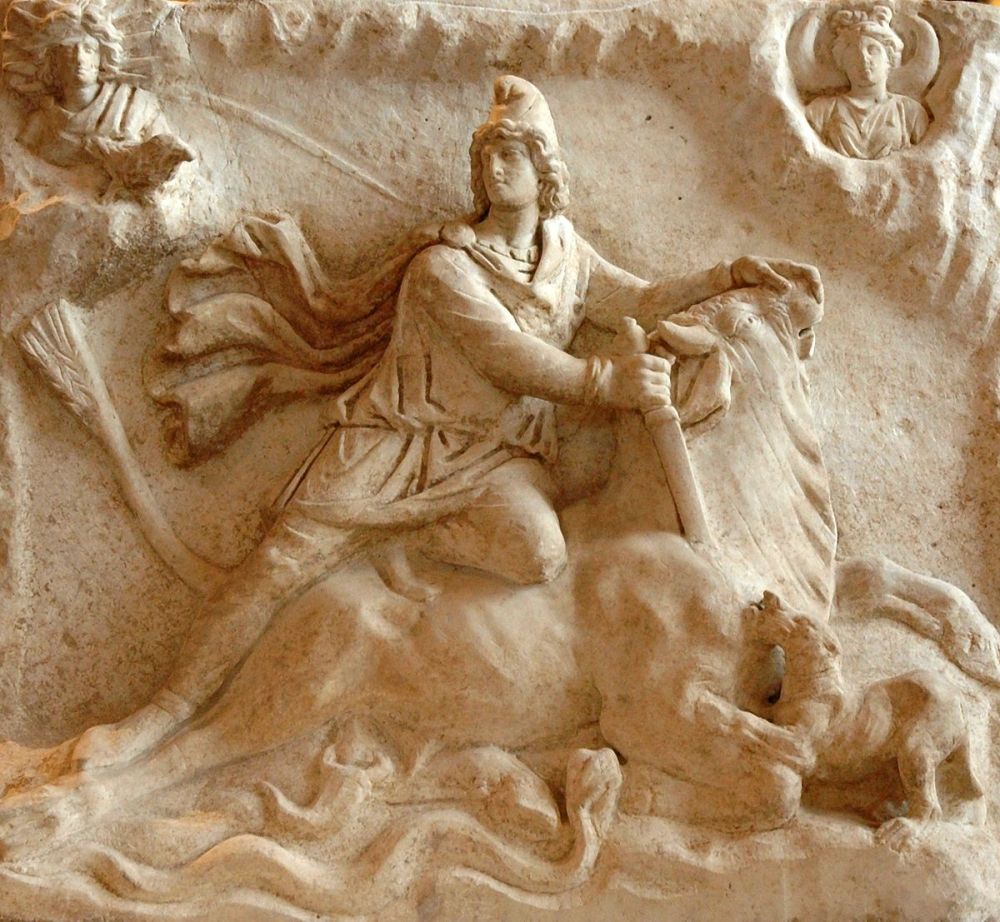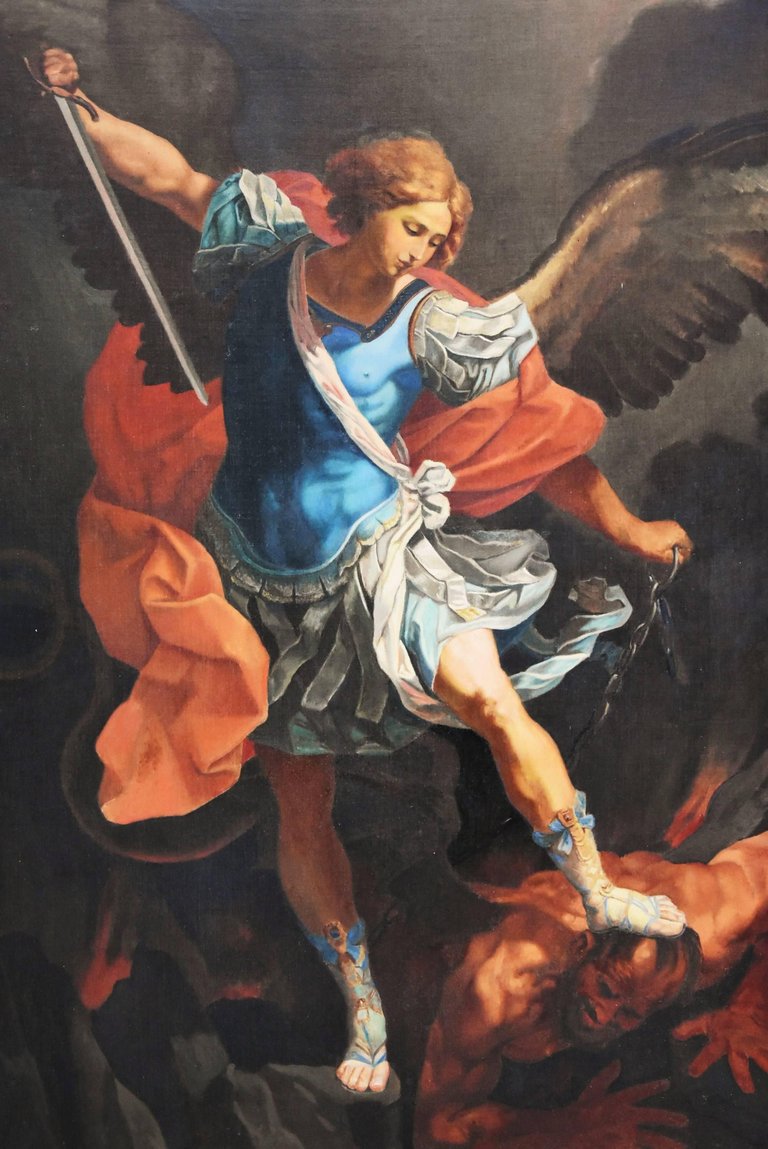Apollo arrives to us as merely the most salvageable and “reformable” solar deity our ancestors developed. He is also the one that arrives most intact despite the best efforts of adversaries, which it appears, were forced to be relatively subtle at first.
Indeed, founding nobilities would naturally associate themselves with the symbol of the dominating, life giving sun. Perhaps, in all cases, these gods were, ultimately, consciously corrupted. In some cases, for example, they were conjoined and subsumed, as in Egypt with Ra, with later appearing Semitic figures. Others were developed from the beginning, falsely, as “ersatz Apollos” and JEM.
Take “Sol”[1] for instance. Sol, to whom no surviving myths are attached, possibly emerges from the Mithra cult, a Semitic personal salvation cult. There Sol appears in mystery religion iconography as an attendant of the Semitic Mithra as the latter slays a white bull. What can be concluded here? Here context is primary. The Mithra cult was an underground, Chthonic cult competing with the likes of Christianity and drawing, as it would turn out, from much of the same symbolism. It is clearer, in fact, to understand them as two “competing brands” introduced by the common “company” or monopoly of Judaism.
On a superficial level, Mithra’s slaying of the bull is synonymous with Apollo’s slaying of Python. In other words, ostensibly it expresses the higher celestial being overcoming the lower earthly being. Yet this is mistaken in my view. In my estimation, the white bull is a depiction of Jupiter. Indeed, the white Bull is among Jupiter’s totems and is connected especially to his abduction of Europa in the Myth of Minos. Yet like Apollo’s “wolf,” or Diana’s “moon,” the “bull” should be considered derogatory. Ultimately, as this study reveals, it is Semitic, associated early with Enlil, Nanna/Sin and the Bull of Heaven appearing in epic of Gilgamesh. Here it is a “status signifier,” indicating the ruling God as mere sacrificial animal and likely also a sexually promiscuous.
As corroboration that these motifs are “ant-establishment” or “anti-patrician” these reliefs frequently feature Mirtha wearing what appears to be a pileus hat, the hat of emancipated slaves. Elsewhere in this study I argue that these hats may in fact be Jewish or proto-Jewish identifiers in Greco-Roman myth, with the kippah being an important symbolic descendent.

Ostensibly Sol eats the bull with Mithra after the sacrifice. Symbolically this is best understood as a repetition of symbolism found in the last supper, containing the same meaning even if the action is reversed. The Semite Mithra, eats the blood of the Aryan Jupiter as opposed to sharing his blood with the world, as would the Jewish Christ. Casting the Semitic protagonist in the active, as opposed to the passive, in contrast to Christianity, may have given the cult more masculine appeal. Indeed, in contrast to Christianity, the cult does appear to have gained some currency among Roman soldiery.
Regardless, the result and esoteric meaning, racial intermixture, is the same. Hence, the “Sun God” Sol emerges as a Jonathan or Michael figure, betraying an Aryan father, and serving the genetic interests of the Semite. Meanwhile Mithra ascends as “King Judah.” In fact, in this context, Mithra, like Christ, may even be intended as that precise figure.
Consider that Mithra was sometimes depicted lion-headed or accompanied by a lion. Likewise he is often depicted with a serpent and among Zodiacal symbols. Hence we see once more the “Jacobean Swap.” Where once Nanna/Sin was the Semitic Bull, Jupiter becomes it. Where once the Aryan Utu/Shamash was associated with the Lion, the Semitic Mithra, like Judah, becomes the Lion. The presence of the serpent, though, reminds us, that he is still the serpent, to wit, Semitic.
In Zoroastrian scripture, Mithra and the sun, Hvare-khshaeta, are separate figures. Yet later Mithra subsumes the solar role. Indeed, here, to the extent Mithra becomes “Solar” is through a subsuming of the Aryan element not dissimilar in all ways from the Amun-Ra conflation appearing in the Egyptian pantheon. To be clear, the latter represents the final symbolic Semitizing of a God and a noble Aryan class.
Even in Christianity itself, we see some occasional efforts to associate Christ with the sun. This is done despite the fact that he is a clear synonym of vegetation gods Adonis and Bacchus and should always be regarded as such. In some cases, as with Christ’s Transfiguration, where he “shines like the sun,” this is best understood as the Semite absorbing Aryan power or again, intermixing with the Aryan Dove or Holy Spirit. Hence often ersatz Apollo’s are better understood as Semitic elements reflecting or absorbing “the sun” rather than originating these primary powers themselves. Otherwise, like Sol or Michael, they are secondary, feminized Aryan figures serving a Semitic master.

[1] Here I mean “Sol” as he developed as a distinct deity, particularly in Rome. This is not a reference to the epithet born by Apollo whereby he is identified with the sun.
how do you think the sun was made feminine in Scandinavia and the moon masculine? does it pertain to the wolf-cult/mannerbunds and the wolf motif being paired with the moon, masculinizing it?
LikeLike
Related to this concept, Brahmin, not sure if you’ve come across Summanus a nocturnal lightning god of Rome, which in my short research might be a proto-Apollo. Saint Augustine claims that Summanus was more exalted than Jupiter originally, but essentially the state sponsored the Jupiter cult (built a grander temple) and the people began to honour him more.
The name, rather than having anything to do with the season summer, is from sub-manus, so “before the morning,” so not of-the-night, but specifically pre-dawn, pre-sun. One writer (Plautus) puts him as god of thieves. Summanalia cakes were shaped like sunwheels made for the summer solstice, but not as sacrifice (does this avoid consumption motif?); chthonic sacrifices were made to Summanus such as black oxen.
From this, Summanus sounds like a Conan-type deity, eugenic lightbringer working by necessity in the night, precursor to Jupiter/Apollo cults. Also wondering whether the Romans were the first to emphasise the diurnal/nocturnal distinction in this specific way.
LikeLike